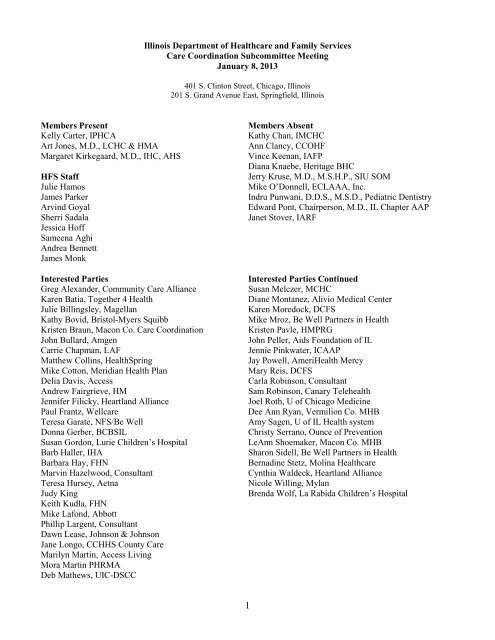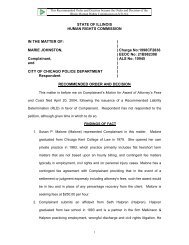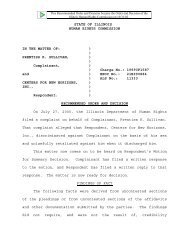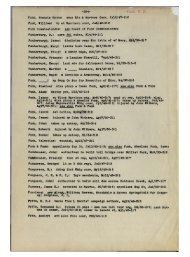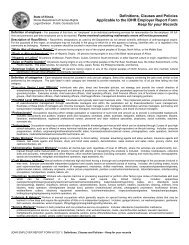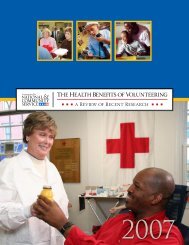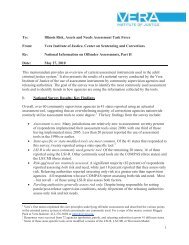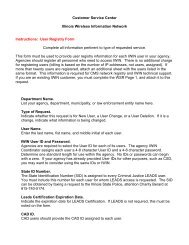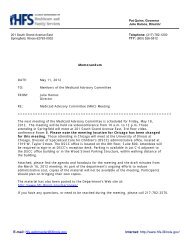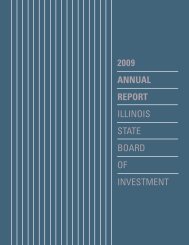E-mail: hfs.webmaster@illinois.gov Internet: http://www.hfs.illlinois.gov/
E-mail: hfs.webmaster@illinois.gov Internet: http://www.hfs.illlinois.gov/
E-mail: hfs.webmaster@illinois.gov Internet: http://www.hfs.illlinois.gov/
You also want an ePaper? Increase the reach of your titles
YUMPU automatically turns print PDFs into web optimized ePapers that Google loves.
Illinois Department of Healthcare and Family ServicesCare Coordination Subcommittee MeetingJanuary 8, 2013I. Call to OrderDr. Art Jones chaired the meeting and called to order at 10:05 a.m.II.III.IntroductionsCommittee members and HFS staff in Chicago and Springfield introduced themselves.Director’s ReportDirector Hamos stated that since the last meeting the Department had published the Care CoordinationRoll-Out Plan for January 2013 through January 2015. A copy was provided and is found online at:<strong>http</strong>://<strong>www</strong>2.illinois.<strong>gov</strong>/<strong>hfs</strong>/SiteCollectionDocuments/010813_maccc_handouts.pdfThe Department had made the awards to the 6 CCEs for the Innovations Project and 8 MCOs for the dualeligiblesproject and now has a robust care coordination roll-out plan. HFS looked at population density inthe state and identified care coordination regions. The Integrated Care Program covers the suburban Cookand collar counties for non dual-eligible seniors and persons with disabilities. Under the InnovationsProject, there is coverage in the Chicago area and in the central Illinois region. The Department is lookingat adding Rockford, Quad cities, and Metro East regions. HFS plans to expand enrollment under theAffordable Care Act (ACA) beginning October 2013 and services to be available starting January 2014.New members would be enrolled in care coordination.The first state legislative hearing on the newly eligible population under the ACA was held January 7 th .There is a bill that has been introduced in the House and the Senate. A coalition of 150, or more,organizations supporting this legislation are talking to legislators statewide. It will be a challenge to get thisbill passed.HFS anticipates about 500,000 new enrollees in Medicaid with two-thirds being the newly eligible. Theseare mostly adults without dependent children. There is a generous federal match of 100% for the first 3years and 90% match over time. There is a bill amendment that ceases this category of eligibility if thefederal funding drops below 90%. Information about the bill will be found on the HFS website under theACA section of the site(<strong>http</strong>://<strong>www</strong>2.illinois.<strong>gov</strong>/<strong>hfs</strong>/PublicInvolvement/AffordableCareAct/Pages/default.aspx ). The Departmentwill also have the twelve point implementation plan to help explain why HFS wants to do this now. TheDepartment hopes that this new group could be added at the same time that the ACA coverage begins.HFS anticipates a big national marketing push to get people to sign up through our partnership exchangeswith assistance from both navigators and providers. People will sign up and many with income at or below133% poverty will be diverted to Medicaid. The State needs to be ready. The Department needs yoursupport to tell legislators that this needs to be acted on now.Q: Dee Ann Ryan asked if there has been discussion about targeting other high cost populations likechildren with severe behavioral health needs.A: James Parker, Deputy Director of Operations, advised that HFS has a solicitation out now for childrenwith complex needs including behavioral health needs. What you would see on the care coordination rolloutplan is that all children would be going into care coordination. He added that there has been somepreliminary discussion with DCFS on some possible alternatives for mental health services for DCFSchildren. Director Hamos added that the Department would like to try a demonstration project with amanaged care approach for those populations.Q1: Dr. Judy King asked about the SMART Act and what was being done to improve birth outcomes.A1: Regarding birth outcomes the Department is developing programs around high-risk moms with sisteragencies, DPH and DHS. A design consideration is not to duplicate and to consolidate services provided.DHS is working on a project to use their case management program in a more targeted way. Executive staffwould be discussing this next week.2
Illinois Department of Healthcare and Family ServicesCare Coordination Subcommittee MeetingJanuary 8, 2013IV.Q2: What is being done for persons moving from incarceration to the community to ensure they havemedical coverage?A2: The Department doesn’t terminate Medicaid when persons are incarcerated, although HFS is notallowed to pay their bills while in prison. The most important component is that the person has the medicalcard when released from jail in order to access health care especially psychiatric drugs. There is no systemin place to track where people are once released. Under the SMART Act Illinois has begun the EnhancedEligibility Verification (EEV) system and there will be a much greater focus on completing the annualredetermination to ensure eligibility. As part of that, the Department has to be able to find people. It ispossible that persons would be terminated if we can’t find them. What needs to happen is having someonestanding at the front door of that jail to connect released persons to a CCE for a needs assessment.Q3: What is HFS doing about increased payment to primary care providers (PCPs) and increasing access?A3: HFS will begin to pay PCPs at the Medicare rate in January and will need to make an announcementabout the process. Payments will be subsequent add-ons made perhaps quarterly. When a claim is initiallyprocessed it will be paid at the state rate and the add-on will come later. HFS needs to segregate the initialpayment so the subsequent payment can be made to get it to the 100% rate. This is complicated by the factthat HFS has some codes that have the MCH payment. Also, the HFS definition of a PCP is different fromthe Feds. HFS is looking at Michigan’s provider enrollment which includes an online enrollment systemmodified to collect the information needed for the add-on payments. HFS is trying to piggy-back onto thatsystem. Because of this, HFS hasn’t sent anything to providers about how to register for those payments.Q: Dr. Jones asked if the Department will be adjusting the MCO premium to reflect that also.A: Based on encounter data, HFS will make a supplemental payment to MCOs with the file that showshow much payment goes to which doctors.Q1: It is true that there will be another round of CCE/MCCN solicitations in the spring?A1: There were additional proposals that came in beyond the 6 proposals that were approved. TheDepartment extended the offer to the additional entities, and is working with them to modify their proposalsfor possible approval. The Department does not intend to offer a new solicitation at this time.Q2: Is the department open to receiving a short white paper on different ideas that are not necessarily aresponse to the solicitation, but fall within the broader framework of a CCE or MCCN targeting apopulation with a specific disease and have a higher coverage cost?A2: The Department has tried to stay away from disease specific proposals. If you focus on individualswith a specific disease, you would still also have to coordinate all of their care. That said, targeting apopulation with high cost condition is something the Department would be interested in.Q: Kelly Carter asked if the Department could announce which MCOs might be approved for the differentgeographic regions for the ICP type expansion in the care coordination roll-out plan.A: The anticipated SPD coverage in the Central Illinois region would be the same as the MMAI plan usingHealth Alliance and Molina with a small exception that Meridian health plan will operate in Peoria, Knox,Stark and Tazewell Counties. In the Rockford area, you would see Aetna, Centene and the CommunityCare Alliance Initiative. For the Quad Cities and Metro East regions, the Department can’t say as yet butwill get something out once the decision is made.Review of October 2, 2012 minutesThere was not a member quorum at the meeting so the minutes could not be approved. There were nocomments made on the October minutes.V. Update on Duals Project3
Illinois Department of Healthcare and Family ServicesCare Coordination Subcommittee MeetingJanuary 8, 2013VI.Status of SolicitationMr. Parker stated, as mentioned earlier, the Department has made awards to eight companies. The sixawardees in the Chicago area are Aetna, Centene, HealthSpring, Humana, BCBSIL and Meridian. The twoawardees in Central Illinois are Health Alliance and Molina.Dual Medicare/Medicaid Care Integration Financial Model ProjectHFS hopes to sign the final Memorandum of Understanding (MOU) with the federal CMS by the end ofJanuary. The MOU is the instrument that officially awards the project in Illinois. Otherwise HFS isworking with the plans to get the system up and running so they will have their networks and be able topass readiness reviews in the summer.The Integrated Care Program Phase 2 is set to launch on February 1 st . Phase 2 adds Long Term Supportsand Services (LTSS) for the 40,000 enrollees managed by Aetna and IlliniCare in the Cook County suburbsand collar counties. On January 24 th , there will be a town hall meeting at JRTC as well as a webinar topresent the two companies’ vision and how this next phase will work. The meeting is for all types of LTSSproviders, and the public, both in the service area and downstate. HFS would like providers, and thepublic, to attend and hopes for a full and robust discussion of questions, issues, operational philosophy,experience and background.Director Hamos stated that with all the projects and new entities going on with coordinated care, theDepartment would like to find a new name that Medicaid clients could say. For example like TennCare forhealth insurance in the state of Tennessee or CountyCare for health insurance in Cook County. Participantswere encouraged to make suggestions for a name for the Illinois managed care programs.Q: Will HFS will put something on its website that will show what plans cover specific geographic areas.A: Yes, This will be developed once contracts are signed. Right now the only contracts in place are theICP contracts with Aetna and IlliniCare. There will be a roll-out pretty quickly and all that will be on thewebsite. There is also a one page description of what this is about and the 3 types of managed care entities.Care Coordination Entities PresentationsMr. Parker stated that the Department is excited to have the CCEs and MCCN representatives here today.He stated that HFS was impressed with how far along the entities are to getting up and running and thecomprehensiveness of their views on what they are trying to do.Each of the four entities represented gave a brief presentation of their background and plans for theirinnovation program. Participants were encouraged to ask questions after each presentation. A summary ofeach presentation is shown below. Additional information can be found online at<strong>http</strong>://<strong>www</strong>3.illinois.<strong>gov</strong>/PressReleases/ShowPressRelease.cfm?SubjectID=2&RecNum=10634Be Well Partners in Health - Sharon Sidell, Director of Psychiatric Services at Methodist Hospital ofChicago presented along with her partners, Teresa Garate of Neumann Family Services and Mark Mroz ofMADO Healthcare Centers. Be Well Health’s partners include: Bethany Homes and Methodist Hospital ofChicago and Norwegian American Hospital; MADO Healthcare that offers short and long term, skilled andintermediate residential, and; Neumann Family Services, a community service placement organizationserving persons with developmental disabilities and the MI population.Ms. Sidell provided a history of the organization describing MADO reaching out to Neumann FamilyServices; Methodist hospital reaching out to MADO to place intensive outpatient services in a residentialcare facility; Norwegian American creating a coordinated care network for patients in the hospital, and;Neumann working with Methodist Hospital to set up the health home for the developmentally disabled. BeWell Partners includes a network of associates that are groups with which they are working on projects andcollaborators that are providers within the community including transportation, pharmacy, therapeuticrehab services and others.4
Illinois Department of Healthcare and Family ServicesCare Coordination Subcommittee MeetingJanuary 8, 2013The Be Well innovation is due to three things. It has two niche hospitals where behavioral medicine is asignificant part of their revenue and they are committed to reducing hospitalization and ER visits for theseriously mentally ill. MADO is committed to transition folks living in an ICF to the community. FinallyNeumann Family Services is committed to the coordinated care model within their system of services.Community Care Alliance of Illinois (CCAI) -The presentation was made by Greg Alexander, CCAIPresident. CCAI is a Managed Care Community Network (MCCN), which is a not-for-profit health planthat is provider owned. It is a subsidiary of Family Health Network (FHN), which has served the TANFpopulation over the past 17 years. CCAI came together as a community partnership anticipating changesthat were occurring in Medicaid. The partnership includes various entities led by Access Living of Chicago,Health and Medicine Policy Research Group (HMPRG) and Sinai Health System. FHN became involved asthey offered the operational and financial capacity to bring this entity to life.CCAI borrows from a successful model pioneered by Dr. Robert Master from the Commonwealth CareAlliance in Boston. It relies heavily on nurse practitioners and a team based approach. CCAI has over 45hospitals and 7,000 providers in the Chicago and Rockford areas. It is a capitated full-risk model whichallows for a person-centered consumer-driven integrated model of care that encompasses medical andbehavioral health as well as LTSS. It will operate much like the Integrated Care Program with a heavyemphasis on health and wellness. CCAI will provide specialized primary care training in the area ofdisability competency as well as training on their model of care.CCAI will be using nurse care coordinators and LTSS coordinators to provide support to the primary carephysician who may already be covering that member. Each member will be enrolled with an interdisciplinarycare team that will do a health risk assessment and care plans addressing six domains ofcare. Service may be provided in enhanced care sites which work with a patient’s existing PCP and helpensure continuity of care. There are also Centers of Excellence that are entities like Rush Hospital and theRehab Institute of Chicago to provide highly specialized care for members with complex needs.One of CCAI’s most innovative elements is for members to have an anchor medical home, or health homes,which are fully disability competent, and are in large part, at hospitals that will work with the interdisciplinarycare teams co-located on-site. Nurse practitioners will also be able to deliver some care in themember’s home.Macon County Care Coordination (MCCC) - Kristen Braun and LeAnn Shoemaker with the MaconCounty Mental Health Board presented. MCCC proposes to run a healthcare plan with a bio-psycho-socialemphasis. The Macon County population is approximately 114,000 with 80% located in Decatur. The basepopulation for the CCE is about 1,400, but will expand. The Macon County Mental Health Board is thelead entity. The core collaborators include Decatur Memorial and Saint Mary’s Hospitals, the community’smajor public health and substance abuse provider, Heritage BHC: the community’s FQHC, CommunityHealth Improvement Center, and SIU Family Practice. There is also an MOU with their long term carefacility which is an IMD facility.The Macon County Mental Health Board, also referred to as a 708 Board, is a unit of county <strong>gov</strong>ernmentthat manages money from local property taxes to fund prevention and treatment services for individualswith mental health, substance abuse, and those who have a developmental disability diagnosis. The 708Board also manages three housing corporations and a Child and Family Connections contract.MCCC will utilize the health home concept to target and serve high-risk, high cost individuals. Triage andscreening will be incorporated to identify those individuals. One of the objectives is to develop individualcare plans and assist the member by improving self management skills.MCCC will work to decrease the current fragmentation in the system by: increasing provider informationsharing, implementing and increasing care coordination in transitional care, building upon and increasingpeer review and teamwork within the network, increasing access to appropriate levels of care, facilitating5
Illinois Department of Healthcare and Family ServicesCare Coordination Subcommittee MeetingJanuary 8, 2013communication in cross treatment settings, and increasing appropriate enrollee identification using passportcards that both hospitals have agreed to enter into their systems. Teams will include APN team leaders,mental health and substance abuse specialists, and navigators helping with linkages and outreach.MCCC is looking at extending the target population and at exploring creation of a centralized electroniccare coordination record and sees care coordination as a viable option in providing care.Together4Health (T4H) - The presentation was made by Karen Batia, Executive Director of HeartlandHealth Outreach and Vice President of Heartland Alliance for Human Needs & Human Rights.Together4Health is a brand new provider network in the Cook County area put together by HeartlandHealth Organization, Inc., and is a separate LLC owned by 34 different organizations that include 5hospitals, many FQHCs, pharmacies, behavioral health providers, and housing providers. T4H also hasorganizations that support the safety net providers with folks like the AIDS Foundation, the Corporation forSupportive Housing and the Treatment Centers for Safe Communities (TASC).The intent of the T4H network is to form regional health home hubs to wrap-around the services forindividuals with serious mental health illnesses and multiple chronic health needs. The goal is to continueto leverage services that folks are already receiving, and go after individuals that are the highest users ofMedicaid through an integrated care plan that promotes physical, mental, and social well-being, whileimproving access to care. T4H will do a health engagement assessment to determine a person’s ability tomanage their illnesses. The Innovations Project brings a unique focus on serving the hard to reachpopulations living in severe poverty and moving in and out of homelessness.The care coordination team within each of the health home hubs will include a nurse, a mental healthspecialist, and community health workers, who will be in people’s homes to help access services in theirneighborhood and help that person navigate what is needed to keep them out of the more expensive care.T4H plans to connect their different partners, which have multiple health information systems, to acentralized data system called AMALGA. This is critical to track the program from a data surveillanceperspective and obtain access to real time data about where people are being seen and what services theyare receiving.Payment reform mechanisms are important. It would be better for T4H to move into a full risk model anduse money flexibly for services that are effective but outside the current Medicaid rules. As a provider lednetwork this is not possible to do yet. With care coordination fees, T4H will use the next few years to workin partnership with HFS to look at opportunities to try some different flexible payment structures.Q: How are the CCEs going to increase access to specialty care?A: T4H members will access care in a variety of ways. Owners are incentivized to connect people whenappropriate. T4H is also using Telehealth for direct services and care coordination.Q: Could you talk more about payment reform?A: There are a number of opportunities through the ACA for the health home option and through theInnovations Project grant structure. There are three ways to finance CCEs; these are care coordination fees,the cost savings sharing model that allows CCEs to used saved money for services not normally coveredunder Medicaid but deemed essential, and the opportunity to request inter-<strong>gov</strong>ernmental transfers whereHFS would discuss with sister agencies using dollars outside the Medicaid system for services that arealready touching CCE enrollees and using those dollars flexibly.Q: What is the status for shared savings in the complex children’s RFP?A: HFS continues to work with Federal CMS on what their tolerance is for matching shared savings. Theconcept is HFS would pay out money that did not need to be paid out because it was saved. As a payment,HFS would seek federal match. The shared savings model would likely look like the ACA model.Q: Are the CCE providers going to be charging copays?6
Illinois Department of Healthcare and Family ServicesCare Coordination Subcommittee MeetingJanuary 8, 2013A: T4H will follow the current Medicaid rules when providing Medicaid services.VII.Outpatient ER UsageA handout, “Outpatient Emergency Room Usage by Month, Pre- and Post- SMART ACT Changes” wasprovided and online at <strong>http</strong>://<strong>www</strong>2.illinois.<strong>gov</strong>/<strong>hfs</strong>/SiteCollectionDocuments/010813_maccc_handouts.pdfMr. Parker advised that HFS had been asked to track ER usage to see if there is an increase as a part ofimplementing the SMART Act. Right now the Department is not seeing an increase. He cautioned thatbecause of the claim lag in the past, any numbers for the recent months should be considered incomplete.One of the changes under the SMART Act was to shorten the billing period from one year to six months sothe numbers should be more complete now than they would have been.The chart column heading, “ER Users - Higher APL” refers to Ambulatory Procedure Listing (APL). Foroutpatient services, HFS pays only one APL. Emergency room service is an APL service. When there aremultiple services, HFS pays only the highest one. If a person goes to the ER and has a procedure morecostly than an ER visit level 1 or 2, it is not listed with an ER code. The chart uses the Higher APLcategory to capture the ER visit.There were suggestions by participants to modify or enhance the data by reporting:• Encounters as per thousand recipients to control for changes in the population• By season as encounter levels may vary by season• Data broken down by basis of eligibility or age group• Data broken down by geography or diagnosis or specific reason for going to the ER• Data over more than a year to allow for better trend analysis• By zip code of the patient or the ER siteDr. Jones noted that looking at ER utilization is a good way to look at access to primary care and how wellpeople are being care managed.Mr. Parker advised that the Department could report rate per thousand, children versus adults and more pre-SMART Act months. One thing HFS has been asked about and will report on is dental diagnosis for adultsat the ER. The Department is also looking at ways to enhance its ability to analyze data that doesn’t comeeasily in a spreadsheet by using new technology or reporting by personnel.Dr. Kirkegaard stated that she believed that one of the questions that this data was trying to sort out was theimpact of copays in the emergency room on both deterring inappropriate ER access and possibly impactingappropriate access. We know there is a high variation in how primary care doctors are enforcing therequirement to collect copays. She was wondering if any of hospital representatives or partners has a senseof how hospitals are collecting the ER copay from patients.Ms. Sidell stated that at her two hospitals, they follow the protocol to make sure a person can’t pay thecopay before writing it off. Otherwise they expect the patient to make the copay.Q: Dr. King asked what instructions are given to hospitals on how to work out patient referrals when theyare unable to make the copay. She stated that under the SMART Act, people now pay more for copays. Herunderstanding is that after the ER assesses that the person has an emergency, before they can charge thecopay, they must know of a place that the person can go to get care.A: There are two different provisions in federal law that allows the Department to impose copays, Section1916 and Section 1916A of the Social Security Act. The provision where you are charging higher copaysis 1916A. The Department has opted to go with nominal copays covered under Section 1916. Theprovision that requires referral to another site with a lower or no copay does not come into play with thenominal copays that the Department charges.Director Hamos added that hospitals are supposed to go on the HFS MEDI system to find the medical7
VIII.IX.Illinois Department of Healthcare and Family ServicesCare Coordination Subcommittee MeetingJanuary 8, 2013home for that person and refer them. She asked if anyone knows if this is happening. Dr. Kirkegaard statedthat IHC has worked extensively with the hospitals to encourage them to do that but the feedback has beenthat it is an onerous administrative process that they can only barely do.Director Hamos stated that this is a process that providers will have to grapple with as the Department willbe discontinuing sending out the monthly medical card. When the provider goes in to check eligibility theywill also need to look at the information on the person’s medical home.Dr. Jones shared that the plan at Medical Home Network (MHN) has an IT solution that is web-based. Assoon as a patient registers in the ED or hospital unit, a real time alert is sent to the primary care home and isalso fed into the screen that the ED doctor is working on. Each ER has integrated this information into theirwork flow so that when ER staff register a patient, information pops up and they can get a print out with apicture of the medical home, directions, PCP name and business hours. This process hasn’t happened yetbut will start once the flag is put on by HFS.This system may allow care coordinators to make contact with a hard to reach member. Participatinghospitals are Rush, Cook County, Sinai, Saint Anthony, Holy Cross, La Rabida and three of the Advocatehospitals. Mercy and UIC plan to go on the system, and University of Chicago is looking at the system. Asthe network expands it will make it possible to see if an MHN member goes to a location other than thepreferred hospital. It should be very easy for the ED to find information.Ms. Batia added that we need to incentivize hospitals to make that connection as part of a systemic solutionto providing more effective care coordination.Affordable Care Act and the FutureDr. Jones asked about the RFP for complex children in which HFS stated that the CCEs needed to meet thecriteria for 2,703 health homes. He asked if the Department could tell the group about when that might beimplemented and where that is in the process.Mr. Parker reviewed that the enhanced federal match for health homes is time limited to eight quarters. Ifyou don’t have all your health homes up and the clock starts, then you will not get as much match.Secondly, CMS won’t approve a state plan match unless health homes are set up for all the differentcategorically eligible people. You have to have health homes for the duals, the AABD population, and theTANF population. For example in a Cook collar county, we have the AABD but don’t have the duals, orparents and children, so it is too soon to pursue the match.2013 Meeting DatesDr. Jones reviewed the dates posted in the meeting notice which are on Tuesdays and are February 5, April9, July 9 and October 8, 2013. Members present did not identify any conflicts with these dates.X. Open to SubcommitteeDr. Jones asked if there additional topics the committee wished to discuss at a future meeting.• Dee Ann Ryan asked if the group could review the Department’s long range vision for the differentcare coordination projects to determine what the best fit is for Illinois.Mr. Parker responded that in the long term, all the models will be evaluated and HFS is definitely interestedin comparing the different models. He stated that on the back end, on the quality measures, all the modelswill be evaluated on the quality metrics for everyone serving the adult disabled and elderly. As theDepartment learns, it may decide to favor a model or not, or just share lessons on models. HFS may seebetter outcomes but not know what caused them. We talked earlier about health assessments. Could wefavor one? The answer today is no.8
Illinois Department of Healthcare and Family ServicesCare Coordination Subcommittee MeetingJanuary 8, 2013Director Hamos added that Illinois is doing managed care the hard way by looking for new models andinnovations for more complex populations. Some states have taken an easier route with Medicaid by justdividing up the regions and picking a couple plans to work first with the easiest populations. Illinois is notdoing the one size fits all approach but is interested in testing new models for more complex populations.She added that in preparing for the town hall meeting and the roll-out of the second phase of the IntegratedCare program, the sister agencies are looking at compiling and releasing “Health and Quality of Life”performance measures. The measures should be available before the town hall meeting.XI.XII.In looking at data, HFS realized that what is collected are “process” measures; like how many people werecontacted, or how many forms were filled out. The plan is to look at health and quality of life measures forseniors and persons with disabilities, and put those out for public review and feedback. Eventually HFSwould ask all our MCEs to be responsible for the same set of health and quality of life measures.• Dr. Jones suggested inviting DHS and DoA staff to discuss opportunities for HFS providers to bestwork with agencies that are being paid under DHS and where can there be collaborations.• Dr. Jones suggested looking at the idea of provider overload that comes about when a provider isworking with six or more care coordination entities and getting different requests for information fromeach. Can we set some common goals to address this?• John Peller would like to discuss some uniform drug formularies for all the CCEs and MCOs.• Phillipe Largent would at some point like to discuss payment reform.Mr. Parker stated that in the context of MCOs that have more flexibility, this could include testing newpayment models like paying hospitals in a different way, covering episodic care or bundled rates.Next MeetingThe next meeting is scheduled for February 5, 2013 at 10 a.m.AdjournmentThe session was adjourned at 11:55 a.m.9


